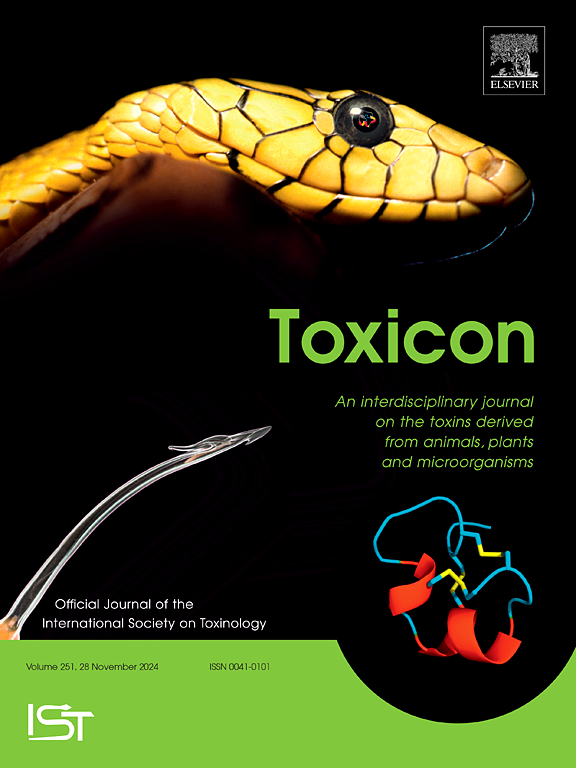尼泊尔喜马拉雅地区黄蜂及其幼虫食虫的毒理后果;病例报告和文献综述。
IF 2.4
4区 医学
Q2 PHARMACOLOGY & PHARMACY
引用次数: 0
摘要
昆虫噬食(或称昆虫消费)是包括尼泊尔在内的亚洲、非洲和南美洲的一种常见传统习俗。尽管这种习俗由来已久,但有关摄入黄蜂幼虫的毒理学影响的文献却十分有限。本病例报告描述了 2023 年 8 月有 7 人在食用煎黄蜂幼虫后出现中毒症状。症状包括抽搐、恶心、头晕、视力模糊和心血管不稳定。病例的严重程度各不相同,一些患者表现出严重的低血压和神经症状。这些症状表明,黄蜂幼虫体内的毒液成分可能具有神经毒性作用,尽管一些研究表明幼虫可能缺乏毒腺。症状的缓慢发展和严重程度突出表明,有必要进一步调查黄蜂幼虫的毒理学特征。未来的研究应侧重于确定黄蜂的特定毒液成分,研究烹饪对毒性的影响,并探索不同黄蜂物种的毒液差异,以改进治疗方法和安全方案。本文章由计算机程序翻译,如有差异,请以英文原文为准。

Toxicological consequences of yellowjacket wasp and its larvae entomophagy in Himalayan region of Nepal; case report and review of literature
Entomophagy, or insect consumption, is a common traditional practice in Asia, Africa, and South America including Nepal. Despite its longstanding cultural presence, there is limited literature on the toxicological effects of ingesting wasp larvae. This case report describes seven individuals who experienced toxicity after consuming pan-fried yellowjacket wasp larvae in August 2023. Symptoms included seizures, nausea, dizziness, blurred vision, and cardiovascular instability. The cases varied in severity, with some patients exhibiting profound hypotension and neurological symptoms. The symptoms suggest possible neurotoxic effects of venom components in wasp larvae, though some studies indicate larvae may lack venom glands. The slow progression and severity of symptoms highlight the need for further investigation into the toxicological profile of wasp larvae. Future research should focus on identifying specific venom components of yellowjackets, examining cooking impacts on toxicity, and exploring venom variations across wasp species to improve treatment approaches and safety protocols.
求助全文
通过发布文献求助,成功后即可免费获取论文全文。
去求助
来源期刊

Toxicon
医学-毒理学
CiteScore
4.80
自引率
10.70%
发文量
358
审稿时长
68 days
期刊介绍:
Toxicon has an open access mirror Toxicon: X, sharing the same aims and scope, editorial team, submission system and rigorous peer review. An introductory offer Toxicon: X - full waiver of the Open Access fee.
Toxicon''s "aims and scope" are to publish:
-articles containing the results of original research on problems related to toxins derived from animals, plants and microorganisms
-papers on novel findings related to the chemical, pharmacological, toxicological, and immunological properties of natural toxins
-molecular biological studies of toxins and other genes from poisonous and venomous organisms that advance understanding of the role or function of toxins
-clinical observations on poisoning and envenoming where a new therapeutic principle has been proposed or a decidedly superior clinical result has been obtained.
-material on the use of toxins as tools in studying biological processes and material on subjects related to venom and antivenom problems.
-articles on the translational application of toxins, for example as drugs and insecticides
-epidemiological studies on envenoming or poisoning, so long as they highlight a previously unrecognised medical problem or provide insight into the prevention or medical treatment of envenoming or poisoning. Retrospective surveys of hospital records, especially those lacking species identification, will not be considered for publication. Properly designed prospective community-based surveys are strongly encouraged.
-articles describing well-known activities of venoms, such as antibacterial, anticancer, and analgesic activities of arachnid venoms, without any attempt to define the mechanism of action or purify the active component, will not be considered for publication in Toxicon.
-review articles on problems related to toxinology.
To encourage the exchange of ideas, sections of the journal may be devoted to Short Communications, Letters to the Editor and activities of the affiliated societies.
 求助内容:
求助内容: 应助结果提醒方式:
应助结果提醒方式:


